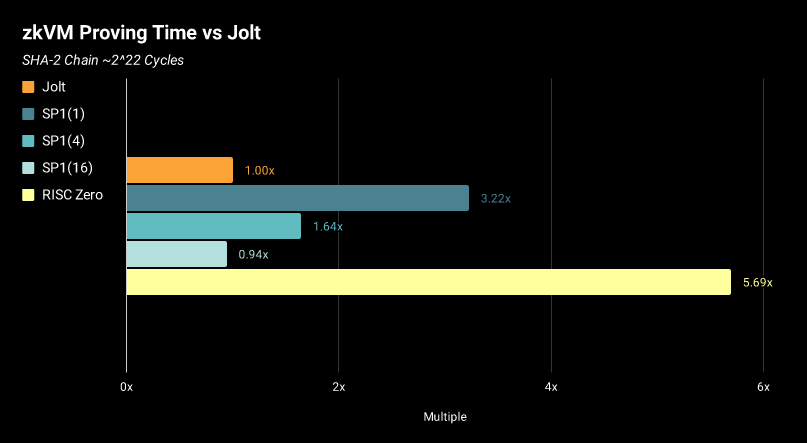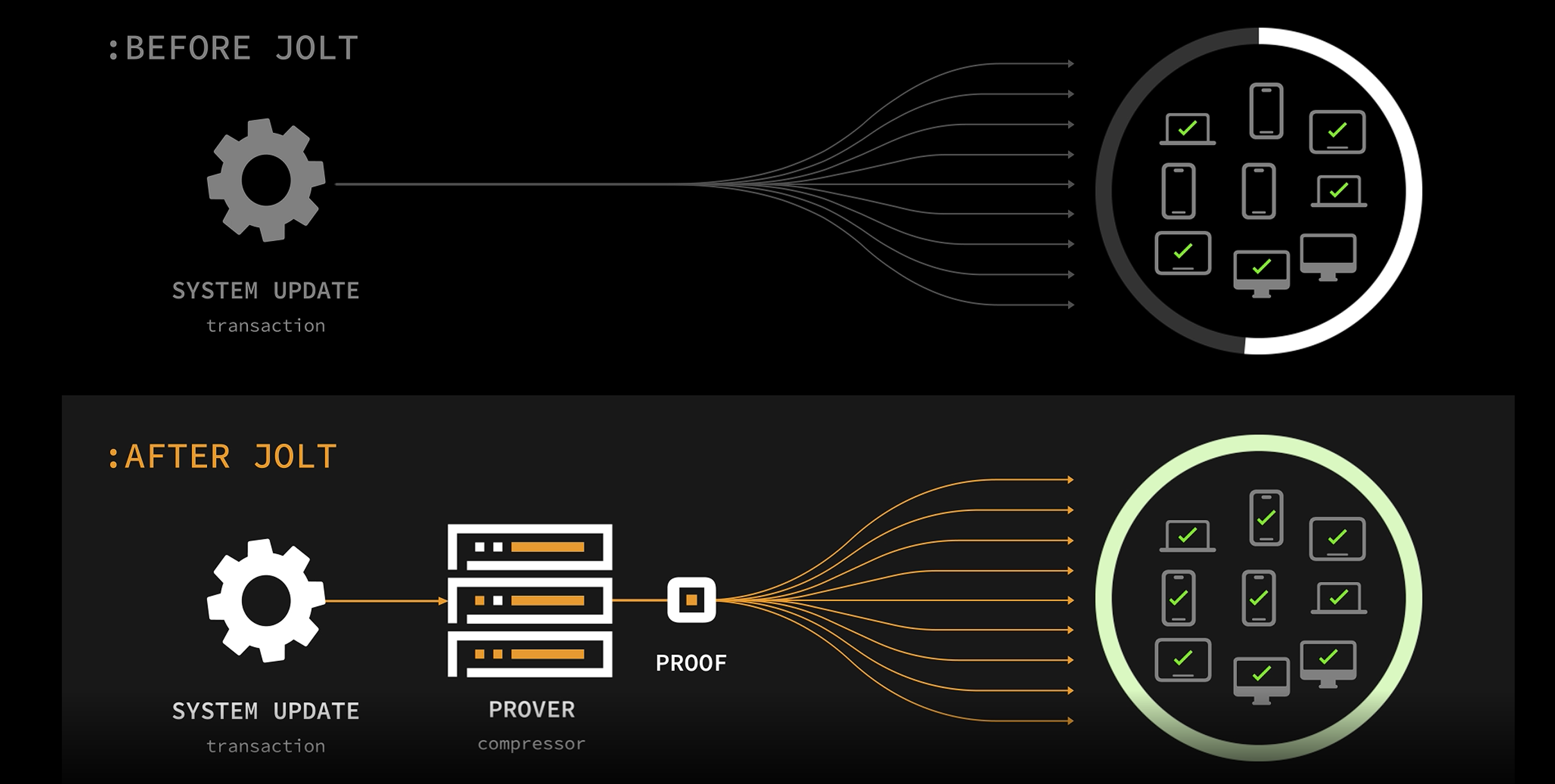What changes will a16z Crypto’s latest zkVM solution Jolt bring?
Written by: Frank, PANews
On April 10, a16z Crypto released a zkEVM solution called Jolt, which aims to accelerate and simplifyBlockchainExtended operations. Jolt integrates SNARK Zero knowledge proof, provides a framework for EVM-compatible Rollups, which can help developers create SNARK-based L2 The team says Jolt is “twice as fast” compared to the current zkVM.
Since the technical principles of Jolt are relatively complex, the following is a brief explanation of the relationships between several technical terms that may be involved:
-
zkSNARK is a powerfulZero knowledge proofPrimitives are the basis for building zkVM and zkEVM
-
zkVM is a general zero-knowledge virtual machine concept that supports any instruction set
-
zkEVM is a special case of zkVM, specifically designed to be compatible with EVM
-
ZK Rollup uses zkVM or zkEVM to improve Ethereum’s scalability while maintaining privacy
What is Jolt?
Jolt is a new type of SNARK solution that provides a simpler and more efficient solution to build zkVM (zero-knowledge virtual machine). In fact, as early as August 2023, a16z crypto Related concepts called Lasso and Jolt have been proposed. These two technologies were proposed against the backdrop of the slow and high cost of SNARK technology.
Lasso is a new lookup parameter that can significantly reduce prover costs; Jolt uses Lasso to provide a new framework for designing SNARKs for so-called zkVMs and broader front ends. Together, they improve the performance, developer experience, and auditability of SNARK design, thereby improving web3 Thus, zero-knowledge proof can be improvedBlockchainField of use.
Before understanding Jolt, you may need to understand zkVM and zkEVM first.
zkVM is a general concept, referring to a zero-knowledge virtual machine. Similar to zkEVM, zkVM allows programs to be written in high-level languages such as C++ or Rust, and then the virtual machine compiles the program into some intermediate representation (such as circuits or arithmetic constraints), and then uses proof systems such as zkSNARK to prove the execution process of the intermediate representation. Compared to zkEVM, zkVM is not limited to compatibility with EVM, but supports any instruction set. Jolt is a high-performance zkVM implementation for the RISC-V instruction set.
We can think of zkVM as a special "black box" that can prove to the outside world that it has indeed performed calculations according to the predetermined program while protecting privacy. However, traditional zkVM requires a lot of tedious calculations in the process of generating this proof, resulting in very poor performance.
Jolt's core innovation is to find a more efficient mathematical method to generate this proof:
First, Jolt cleverly transforms the computation to be proved into a special polynomial, which we call a “computational polynomial.” The characteristic of this polynomial is that its value will be equal to zero only when the black box actually performs the computation correctly.
In order to prove that the value of the "computational polynomial" is equal to zero, Jolt uses an interactive protocol called "sumcheck". This protocol can convince the verifier that the value of the polynomial is zero in a relatively short time without actually calculating the entire polynomial. This is a bit like a teacher checking only a few questions of a student to determine whether the entire test paper is correct.
Jolt's technical advantages
The technical principle of Jolt is very complicated. In the development of blockchain networks, zkVM is a key technology that improves the scalability of blockchain networks and can provide effective proof while ensuring privacy. Vitalik gave a detailed discussion on zkSNARK technology in his keynote speech at the recent Hong Kong Web3 Carnival. Vitalik said: "Finding ZKSNARKS is very useful in terms of privacy and scalability."
However, the speed and computational overhead of proof generation have always been a major challenge for the practical application of zkSNARK technology, and it has also been a hot topic in academia and industry in recent years.Xiaobai NavigationKey research direction. Traditional zkSNARK solutions, such as Pinocchio and Groth16, may take several hours or even days to generate proofs when proving more complex computational logic, and require a large amount of memory and storage resources. This performance bottleneck seriously restricts the application of zkSNARK in many practical scenarios.
If we want to realize large-scale application of blockchain and achieve real-time verification, improving the performance of zkSNARK is a critical step.

Specifically, the proof generation process of zkSNARK involves complex cryptographic algorithms, such as elliptic curve pairing, polynomial interpolation, etc. These operations consume a lot of computing resources. Especially when the scale of the computing circuit to be proved is large, the computational complexity of proof generation will increase exponentially.
According to a16z Crypto, on CPUs, the initial Jolt implementation is about 6 times faster than RISC Zero, 2 times faster than the recently released SP1, and will increase Jolt speed by about 1.5 times in the coming weeks.
Jolt is currently more than 2 times faster than the existing zkVM, but there is still a lot of room for optimization.
Jolt also cleverly exploits certain algebraic properties of polynomials to implement a more efficient polynomial commitment scheme. This further reduces the size of the proof and the time to verify.
Possible changes brought by Jolt
From an engineering perspective, Jolt uses a series of optimization methods, such as more compact circuit design, more efficient pipelines, more complete parallelization, etc., to maximize the computing power of the hardware.
Suppose you are a Web3 developer who wants to deploy an on-chain poker game on Ethereum. This game requires shuffling, dealing, and comparing cards on the chain, and each operation needs to go through the zkVM circuit to achieve privacy protection and verifiability.
If you use an existing zkVM solution such as ZoKrates or Bellman, it may take several hours or even days to build such a circuit. Because the current zkVM performance is still relatively low, generating zero-knowledge proofs for complex circuits requires a lot of computing resources and time. This means that the development and testing cycle will be very long.
If you use Jolt to build the same circuit, the situation will change significantly. According to the Jolt team's tests, the current Jolt implementation generates proofs 2-5 times faster than the mainstream zkVM solution. This means that if it originally took 10 hours to generate a proof, it may now only take 2-5 hours.

In general, the 2-5 times performance improvement brought by Jolt means that the availability and ease of use of zkVM technology have been greatly improved. This will significantly lower the threshold for Web3 developers, shorten the application development cycle, and bring a better user experience to end users. In the longer term, Jolt is expected to accelerate the large-scale application of zkVM technology, allowing more privacy protection and verifiable computing power to benefit every Web3 user.
Of course, Jolt is still in the early stages of development, and a 2-5x performance improvement is just the beginning. With the continuous iteration and optimization of Jolt technology, the performance of zkVM will be further improved, ultimately paving the way for large-scale application of Web3.
The article comes from the Internet:What changes will a16z Crypto’s latest zkVM solution Jolt bring?
如果你不了解 Memecoin,那么在很长一段时间内,加密货币对你来说都是没有意义的。 撰文:Byron Gilliam 编译:Luffy,Foresight News 当理查德道金斯为他的「文化传播单位」概念寻找一个术语时,他选择了「Meme」——「gene…